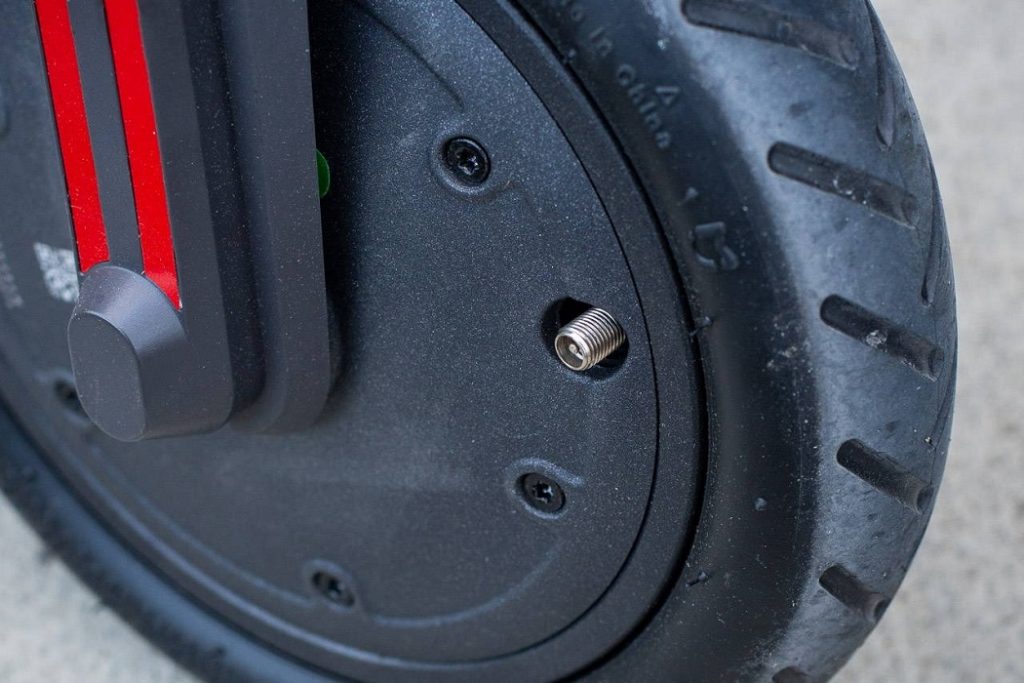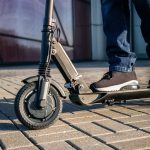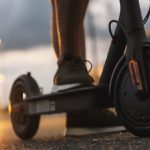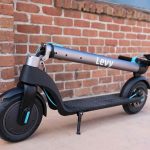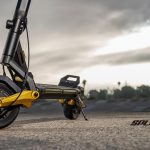Electric scooters have taken the urban transportation scene by storm, providing an eco-friendly and convenient way to navigate crowded city streets. However, for all their sleek design and technological advancements, it’s easy to overlook one of the most critical components of an electric scooter: the tires. As an enthusiast and expert in the field of electric scooters, I’ve not only extensively tested various models but have also come to appreciate the importance of tires and the hidden benefits that come with choosing the right ones.
The Importance of Electric Scooter Tires
Tires are the unsung heroes of electric scooters. They’re the only point of contact between you and the road, playing a pivotal role in your safety, comfort, and overall riding experience. Here’s why they matter:
- Safety: The right tires can significantly impact your scooter’s traction and stability, especially when navigating through wet or uneven terrain. High-quality tires reduce the risk of slipping or skidding, helping you maintain control in challenging conditions.
- Comfort: A smooth and comfortable ride is essential for enjoying your electric scooter to the fullest. The right tires can absorb shocks and vibrations from rough roads, potholes, and bumps, ensuring a more enjoyable journey.
- Range and Efficiency: Tires also influence the energy efficiency of your scooter. A well-designed tire with low rolling resistance can extend your scooter’s battery life and maximize your range, allowing you to travel longer distances on a single charge.
- Handling and Maneuverability: Different tire profiles can affect how your scooter handles. Narrower tires offer better agility and are ideal for urban commuting, while wider tires provide stability and enhanced grip, making them suitable for off-road adventures.

Types of Electric Scooter Tires
Electric scooter tires come in various types, each designed for specific purposes:
- Pneumatic (Air-Filled) Tires: These tires are similar to those on bicycles and offer a comfortable ride with excellent shock absorption. They are ideal for city commuting and casual rides but may require more maintenance to prevent flats.
- Solid Tires: Solid rubber tires are virtually maintenance-free and puncture-proof, making them perfect for urban riders who want hassle-free commuting. However, they provide a slightly harsher ride compared to pneumatic tires.
- Hybrid Tires: These tires combine the best of both worlds, with a solid core surrounded by a pneumatic outer layer. They offer a compromise between comfort and durability, making them suitable for a wide range of riding conditions.
- Off-Road Tires: If you plan to take your electric scooter on trails, gravel paths, or uneven terrain, off-road tires with aggressive treads provide the necessary grip and stability for a safe adventure.
When it comes to electric scooters, the tires you choose can make a world of difference in your riding experience. Safety, comfort, efficiency, and even environmental impact are all influenced by this seemingly small component. As you embark on your electric scooter journey, remember that investing in the right tires is a decision that will pay off in more ways than one, ensuring you enjoy every moment of your urban exploration.
Scooter Tires
| Tire Type | Pros | Cons | Best For |
|---|---|---|---|
| Pneumatic (Air-Filled) | – Excellent shock absorption | – Prone to punctures and flats | – City commuting |
| – Comfortable ride | – Requires maintenance | – Casual rides | |
| – Good traction on various surfaces | |||
| Solid Tires | – Puncture-proof and low-maintenance | – Slightly harsher ride | – Urban commuting |
| – Durable and long-lasting | – Hassle-free use | ||
| – No risk of flats | |||
| Hybrid Tires | – Balance of comfort and durability | – Not as puncture-proof as solid tires | – Versatile use |
| – Less maintenance compared to pneumatic | – Wide range of riding conditions | ||
| – Suitable for various terrains | |||
| Off-Road Tires | – Aggressive treads for superior grip | – Reduced efficiency on smooth surfaces | – Off-road adventures |
| – Enhanced stability on uneven terrain | – May produce more noise | – Trails and gravel paths | |
| – Excellent traction in challenging conditions | – Rough and uneven terrain |
This table should help you make an informed decision when choosing the right tires for your electric scooter, based on your specific needs and preferences.

Pneumatic (Air-Filled) Scooter Tires
Pneumatic (air-filled) scooter tires are the most common type of tires found on electric scooters, appreciated for their versatility and comfortable ride quality. These tires feature an inner tube filled with air, providing a cushioning effect that absorbs shocks and vibrations from uneven terrain, making them ideal for urban commuting and casual rides.
With their excellent grip on various surfaces, including asphalt and concrete, pneumatic tires offer enhanced traction and control, ensuring a safe and stable riding experience. However, they do require regular maintenance to check and maintain proper air pressure to prevent flats, making them a preferred choice for riders willing to invest a bit of extra care for the benefits of a smoother and more enjoyable ride.
Specifications
| Specification | Description |
|---|---|
| Tire Type | Pneumatic (Air-Filled) |
| Tire Material | Rubber outer casing with an inner tube filled with air |
| Tire Size | Varies by scooter model; typically ranging from 8 to 10 inches in diameter |
| Tread Pattern | Varies by tire model; street, all-purpose, or hybrid treads |
| Recommended Pressure | Typically ranges from 30 to 50 PSI (pounds per square inch) |
| Sidewall Construction | Reinforced sidewalls for added durability |
| Shock Absorption | Excellent due to air-filled design |
| Grip and Traction | Good grip on various surfaces, including asphalt and concrete |
| Maintenance | Requires regular pressure checks and occasional tube replacement or patching |
| Ride Comfort | Offers a comfortable and smooth ride with reduced vibrations |
| Versatility | Suitable for urban commuting, casual rides, and mixed-terrain |
| Durability | Durable with proper maintenance; may be prone to flats |
| Common Usage | Found on a wide range of electric scooter models |
These specifications highlight the key characteristics and considerations for pneumatic (air-filled) scooter tires, which are known for their comfortable ride and versatility on different surfaces.

Pros & Cons
Pros:
- Comfortable Ride: Pneumatic tires provide a cushioned and comfortable ride due to their ability to absorb shocks and vibrations, resulting in reduced rider fatigue.
- Excellent Traction: These tires offer good grip on various surfaces, including smooth pavements, wet roads, and uneven terrain, enhancing stability and control.
- Versatility: Pneumatic tires are suitable for a wide range of riding conditions, making them ideal for urban commuting, casual rides, and mixed terrain.
- Shock Absorption: The air-filled design effectively absorbs shocks and impacts from bumps, potholes, and uneven surfaces, enhancing rider comfort and safety.
- Customizable Pressure: Riders can adjust the tire pressure to suit their preferences, optimizing comfort, grip, and efficiency.
- Energy Efficiency: Properly inflated pneumatic tires can contribute to better energy efficiency and increased range on a single charge.
Cons:
- Maintenance Required: Pneumatic tires demand regular maintenance to check and maintain the correct air pressure. Neglecting this can lead to flats or a less-than-optimal ride.
- Puncture Risk: Despite efforts to maintain proper pressure, pneumatic tires are still susceptible to punctures from sharp objects, requiring repairs or replacements.
- Inconsistent Performance: Performance can vary based on tire pressure, so maintaining the correct pressure is crucial for a consistent riding experience.
- Not Puncture-Proof: Unlike solid or foam-filled tires, pneumatic tires are not puncture-proof, making them less suitable for riders who prioritize hassle-free maintenance.
- Environmental Impact: Over time, pneumatic tires can contribute to microplastic pollution as they wear down and release tiny rubber particles into the environment.
- Increased Maintenance Cost: The need for occasional tube replacements or patching, as well as the cost of a quality pump and gauge, can add to the overall cost of ownership.
In summary, pneumatic (air-filled) scooter tires offer a comfortable and versatile riding experience with excellent traction but require regular maintenance and are vulnerable to punctures. Choosing these tires depends on a rider’s preference for comfort and willingness to invest in maintenance.
Solid Scooter Tires
Solid scooter tires, also known as puncture-proof or airless tires, represent a low-maintenance alternative to traditional pneumatic (air-filled) tires. These tires are constructed from solid rubber or foam materials, eliminating the need for inner tubes and air pressure. Solid tires are virtually puncture-proof, making them an attractive choice for riders who want hassle-free commuting and reduced maintenance.
While they may provide a slightly harsher ride due to the absence of air cushioning, they offer enhanced durability, improved stability, and the peace of mind that comes with knowing you won’t encounter flat tires on your journey. Solid scooter tires are particularly popular among urban commuters seeking a low-maintenance and reliable solution for their daily rides.

Specifications
| Specification | Description |
|---|---|
| Tire Type | Solid (Puncture-Proof or Airless) |
| Tire Material | Solid rubber or foam construction |
| Tire Size | Varies by scooter model; typically ranging from 8 to 10 inches in diameter |
| Tread Pattern | Treadless or minimal tread patterns |
| Recommended Pressure | Not applicable; no air pressure is required |
| Sidewall Construction | Solid and rigid sidewalls |
| Shock Absorption | Limited shock absorption; firmer ride compared to pneumatic tires |
| Grip and Traction | Decent grip on smooth surfaces, but reduced compared to pneumatic tires |
| Maintenance | Virtually maintenance-free; no need to check or adjust air pressure |
| Ride Comfort | Provides a firmer and less cushioned ride compared to pneumatic tires |
| Versatility | Ideal for urban commuting and smooth pavements, less suitable for rough terrain |
| Durability | Highly durable and puncture-proof; less prone to flats |
| Common Usage | Preferred by riders seeking low-maintenance and hassle-free commuting |
These specifications highlight the key characteristics of solid scooter tires, which are known for their durability, puncture resistance, and low-maintenance benefits, making them a popular choice among urban commuters.
Pros & Cons
Pros:
- Puncture-Proof: Solid tires are virtually puncture-proof, eliminating the risk of flats from sharp objects like nails or glass on the road.
- Low Maintenance: These tires require minimal maintenance because there’s no need to check or adjust air pressure, making them hassle-free for riders.
- Durability: Solid tires are highly durable and resistant to wear and tear, resulting in a longer lifespan compared to pneumatic tires.
- Stability: They provide stable and predictable handling, particularly on smooth surfaces, enhancing rider confidence and control.
- Consistent Performance: Solid tires offer consistent performance regardless of the terrain or surface, reducing the need for adjustments based on riding conditions.
- Environmentally Friendly: Solid tires don’t contribute to microplastic pollution as they wear down, making them a more eco-friendly choice.

Cons:
- Ride Comfort: Solid tires offer a firmer and less cushioned ride compared to pneumatic tires, which can result in increased vibrations and discomfort on rough terrain.
- Reduced Traction: While they provide decent grip on smooth surfaces, solid tires may have reduced traction, especially on wet or slippery roads, compared to pneumatic tires.
- Limited Shock Absorption: Solid tires have limited shock-absorbing capabilities, which can lead to a bumpier and less comfortable ride on uneven terrain.
- Less Versatile: They are best suited for urban commuting on smooth pavements and may not perform well on rough or off-road surfaces.
- Impact on Battery Life: The firmer ride of solid tires may result in slightly increased energy consumption, potentially reducing the scooter’s range on a single charge.
- Initial Cost: Solid tires may have a higher initial cost compared to pneumatic tires, but they often make up for it in reduced maintenance expenses.
In summary, solid scooter tires are praised for their puncture resistance, low maintenance, and durability but come with trade-offs in terms of ride comfort and reduced traction on certain surfaces. Choosing solid tires depends on a rider’s priorities and the types of terrain they frequently encounter during their scooter journeys.
Hybrid Scooter Tires
Hybrid scooter tires, sometimes referred to as semi-pneumatic or air-infused tires, offer a unique blend of features that combine the benefits of both pneumatic and solid tires. These tires typically feature a solid core with a pneumatic outer layer, providing a compromise between comfort and durability. The solid core ensures resistance to punctures and flats while offering a more cushioned and comfortable ride than fully solid tires.
At the same time, the pneumatic outer layer provides improved shock absorption and grip on various surfaces, making hybrid tires versatile for riders who navigate urban streets, gravel paths, and occasional off-road terrain. This versatility, along with reduced maintenance compared to traditional pneumatic tires, makes hybrid scooter tires an appealing choice for riders seeking a balanced and adaptable solution for their electric scooters.

Specifications
| Specification | Description |
|---|---|
| Tire Type | Hybrid (Semi-Pneumatic or Air-Infused) |
| Tire Material | Solid core with a pneumatic outer layer |
| Tire Size | Varies by scooter model; typically ranging from 8 to 10 inches in diameter |
| Tread Pattern | Varied tread patterns, combining elements from both pneumatic and solid tires |
| Recommended Pressure | Typically ranges from 30 to 50 PSI for the pneumatic outer layer |
| Sidewall Construction | Solid and rigid core, pneumatic outer layer with flexible sidewalls |
| Shock Absorption | Moderate to good shock absorption due to the pneumatic outer layer |
| Grip and Traction | Decent grip on various surfaces, offering better traction compared to solid tires |
| Maintenance | Requires less maintenance compared to fully pneumatic tires, occasional pressure checks |
| Ride Comfort | Provides a balance between comfort and durability, offering a smoother ride than fully solid tires |
| Versatility | Versatile for various riding conditions, suitable for urban commuting and mixed-terrain |
| Durability | Durable with resistance to punctures and flats thanks to the solid core |
| Common Usage | Preferred by riders seeking a compromise between comfort and puncture resistance |
These specifications showcase the key characteristics of hybrid scooter tires, which strike a balance between comfort and durability while offering versatility for different riding conditions.
Pros & Cons
Pros:
- Versatility: Hybrid tires offer a versatile solution for various riding conditions, making them suitable for urban commuting, mixed terrain, and occasional off-road adventures.
- Comfortable Ride: They provide a smoother and more comfortable ride compared to fully solid tires, thanks to the pneumatic outer layer’s shock-absorbing properties.
- Puncture Resistance: Hybrid tires feature a solid core that is resistant to punctures and flats, ensuring a reliable and low-maintenance option.
- Improved Grip: These tires offer better traction on different surfaces compared to fully solid tires, enhancing stability and control.
- Reduced Maintenance: While not entirely maintenance-free, hybrid tires require less maintenance than traditional pneumatic tires, as they are less prone to punctures.
- Durability: The solid core of hybrid tires enhances their durability, making them a long-lasting choice for electric scooters.

Cons:
- Cost: Hybrid tires may have a higher initial cost compared to fully pneumatic or solid tires, which can be a consideration for budget-conscious riders.
- Maintenance Required: While requiring less maintenance than fully pneumatic tires, hybrid tires still need occasional pressure checks to ensure optimal performance.
- Not Fully Puncture-Proof: While the solid core reduces the risk of punctures, hybrid tires can still be vulnerable to damage in certain situations, particularly on rough or sharp terrain.
- Weight: Hybrid tires can be slightly heavier than fully pneumatic tires due to their combination of solid and pneumatic components, which can impact scooter agility.
In summary, hybrid scooter tires offer a versatile and comfortable riding experience with improved puncture resistance compared to fully pneumatic tires. However, they come with a higher initial cost and still require some maintenance, making them a suitable choice for riders seeking a balanced compromise between various factors.
Off-Road Scooter Tires
Off-road scooter tires are purpose-built for adventurers and thrill-seekers who yearn to explore rugged and challenging terrains. These specialized tires feature aggressive tread patterns with deep grooves and robust construction to tackle dirt trails, gravel paths, mud, sand, and rocky surfaces with confidence. Off-road scooter tires provide superior grip, stability, and control on uneven terrain, allowing riders to navigate through rough landscapes while maintaining balance and traction.
With excellent shock absorption capabilities, they absorb the impacts and vibrations of off-road obstacles, delivering a more comfortable and thrilling ride. These tires open up a world of off-road possibilities, enabling riders to embark on exciting adventures and explore nature trails and rough terrain that would be challenging for standard scooter tires.

Specifications
| Specification | Description |
|---|---|
| Tire Type | Off-Road (Designed for rugged and uneven terrain) |
| Tire Material | Rubber compound with reinforced sidewalls for durability |
| Tire Size | Varies by scooter model; typically larger with aggressive tread patterns for off-road use |
| Tread Pattern | Aggressive and deep grooves for enhanced traction and control |
| Recommended Pressure | Lower pressure range, often between 20 to 30 PSI |
| Sidewall Construction | Reinforced sidewalls to resist damage from rocks and debris |
| Shock Absorption | Excellent shock absorption to handle bumps, roots, and rough terrain |
| Grip and Traction | Outstanding grip on dirt, gravel, mud, sand, and rocky surfaces |
| Maintenance | Requires regular inspection for cuts, tears, and tire wear; occasional pressure checks |
| Ride Comfort | Provides a comfortable ride even on uneven and rough terrain |
| Versatility | Primarily designed for off-road adventures and rugged trails |
| Durability | Highly durable to withstand the rigors of off-road riding |
| Common Usage | Preferred by off-road enthusiasts and riders seeking adventure on challenging terrain |
These specifications highlight the key characteristics of off-road scooter tires, which are engineered for maximum traction, durability, and control on rough and challenging terrains.
Pros & Cons
Pros:
- Superior Traction: Off-road scooter tires offer outstanding grip on challenging terrains like dirt trails, gravel paths, mud, sand, and rocky surfaces, providing excellent traction and control.
- Enhanced Stability: They contribute to improved stability and control, even when riding on uneven and rough terrain, reducing the risk of accidents.
- Excellent Shock Absorption: Off-road tires are designed to absorb shocks and impacts from bumps, rocks, roots, and other obstacles, ensuring a smoother and more comfortable ride.
- Durability: These tires are built to withstand the rigors of off-road riding, with reinforced sidewalls and rugged construction that resist damage from rocks and debris.
- Adventure Possibilities: Off-road tires open up a world of adventure possibilities, allowing riders to explore nature trails, remote paths, and challenging landscapes that would be inaccessible with standard scooter tires.

Cons:
- Limited Versatility: Off-road tires are specialized for rough terrain and may not perform as well on smooth, paved surfaces, leading to reduced efficiency and comfort during city commuting.
- Higher Rolling Resistance: Due to their aggressive tread patterns, off-road tires can have higher rolling resistance, which may require more effort and energy for propulsion.
- Maintenance: These tires require regular inspection for cuts, tears, and wear, as they can be more susceptible to damage in off-road conditions.
- Noise: The aggressive treads on off-road tires may produce more noise when riding on smooth surfaces compared to tires with a street-oriented tread pattern.
In summary, off-road scooter tires excel in providing exceptional traction and control on rugged terrains, making them the ideal choice for adventure enthusiasts. However, their specialized design can result in reduced performance and comfort on smooth surfaces, making them less versatile for urban commuting.
The Hidden Benefits of the Right Tires
Choosing the right tires for your electric scooter isn’t just about safety and comfort; it can also bring hidden benefits that enhance your overall experience:
- Reduced Maintenance: Quality tires are more durable and less prone to flats, saving you money on replacements and repairs.
- Noise Reduction: The right tires can reduce road noise, making for a quieter and more pleasant ride, both for you and those around you.
- Environmental Impact: Tires with low rolling resistance contribute to energy efficiency, which, in turn, reduces your carbon footprint and environmental impact.

Types of Tread
Tread patterns play a crucial role in the performance and suitability of tires for electric scooters. Here’s an overview of the most common types of tread patterns you may encounter:
| Tread Pattern | Description | Benefits | Best For |
|---|---|---|---|
| Street Tread | – Shallow, closely spaced grooves | – Excellent grip on smooth surfaces | – City commuting |
| – Low rolling resistance for efficient urban riding | – Comfortable ride | – Casual rides | |
| – Good traction on asphalt and concrete | – Reduced noise | ||
| All-Purpose Tread | – Moderate-depth grooves with moderate spacing | – Versatility for a range of surfaces | – Varied terrain |
| – Suitable for pavement, gravel, and light off-road | – Decent grip on various surfaces | – Mixed riding conditions | |
| Off-Road Tread | – Deep, aggressive grooves with wide spacing | – Superior traction on challenging terrain | – Off-road adventures |
| – Excellent stability and control on rough surfaces | – Reduced risk of slipping or skidding | – Trail riding, gravel paths | |
| Rain Tread | – Water-dispersing grooves designed for wet weather | – Enhanced grip on wet or slippery surfaces | – Rainy or wet conditions |
| – Reduced risk of hydroplaning | – Improved safety in adverse weather | – Regions with frequent rain | |
| Slick Tread | – Completely smooth surface without grooves | – Lowest rolling resistance for maximum speed | – Smooth, dry roads |
| – Maximum contact area with the road surface | – Efficiency and speed | – Speed-focused riding | |
| Hybrid Tread | – Combination of different tread elements | – Versatile compromise between efficiency and grip | – Various riding conditions |
| – Smoother center section for reduced resistance | – Adaptability to different terrains | – Diverse riding styles |
Keep in mind that choosing the right tread pattern for your electric scooter tires depends on your typical riding conditions and priorities. Whether you’re a city commuter, an off-road adventurer, or somewhere in between, selecting the appropriate tread pattern can significantly enhance your overall riding experience.

When selecting electric scooter tires, consider the type of terrain you’ll encounter on your regular routes and your riding preferences. The right tread pattern can significantly enhance your scooter’s performance, safety, and overall riding experience, ensuring you have a smooth journey whether you’re commuting in the city or exploring off-road trails.
What’s the Right Tread for Me?
Selecting the right tread for your electric scooter tires depends on your specific riding needs and preferences. Here’s a guide to help you determine which tread pattern is best suited for you:
- Street Tread:
- Best For: City commuters and riders who primarily use well-paved roads and smooth sidewalks.
- Benefits: Offers excellent grip on asphalt and concrete, provides a comfortable and efficient ride on urban terrain, and reduces noise. Street treads are perfect for everyday city riding.
- All-Purpose Tread:
- Best For: Riders who encounter a mix of surfaces, including pavement, gravel paths, and occasional off-road conditions.
- Benefits: Versatile and suitable for various terrains, providing decent grip on a range of surfaces. All-purpose treads are a good choice for those with diverse commuting routes.
- Off-Road Tread:
- Best For: Adventurous riders who frequently tackle challenging terrains like dirt trails, gravel roads, and uneven surfaces.
- Benefits: Offers superior traction, stability, and control on rough terrain. Off-road treads are essential for riders who seek off-road adventures.
- Rain Tread:
- Best For: Those who ride in regions with frequent rain or prioritize safety in wet conditions.
- Benefits: Enhanced grip on wet or slippery surfaces and reduced risk of hydroplaning. Rain treads improve safety and confidence in rainy weather.
- Slick Tread:
- Best For: Speed enthusiasts and riders on well-maintained, dry roads where efficiency and speed are paramount.
- Benefits: Provides the lowest rolling resistance for maximum speed and efficiency on smooth surfaces. Slick treads are ideal for city riders seeking optimal performance.
- Hybrid Tread:
- Best For: Riders looking for a compromise between efficiency and grip in various conditions.
- Benefits: Offers adaptability to different terrains with a mix of smooth and grip-focused tread elements. Hybrid treads cater to a wide range of riding styles.

To determine the right tread for you, consider the following factors:
- Typical Riding Surface: Analyze the type of terrain you encounter most frequently during your rides. If you mainly ride on city streets, a street or slick tread might be suitable. For varied terrains, consider all-purpose or hybrid treads.
- Weather Conditions: If you often ride in wet or rainy weather, prioritize tires with rain or all-weather treads for improved traction and safety.
- Riding Style: Are you a speed-focused rider, a casual commuter, or an off-road enthusiast? Your riding style and goals will influence your tire choice.
- Comfort vs. Performance: Determine whether you prioritize comfort or performance. Some treads offer a smoother ride, while others optimize efficiency and speed.
Ultimately, the right tread for you will enhance your riding experience, making your electric scooter journeys safer and more enjoyable. Carefully assess your needs and preferences to choose the perfect tire for your specific riding conditions.
Right Tire Pressure
Getting the right tire pressure for your electric scooter is crucial for safety, performance, and overall riding enjoyment. Proper tire pressure ensures optimal traction, stability, and efficiency. Here’s a step-by-step guide to help you determine and maintain the correct tire pressure:
1. Check the Manufacturer’s Recommendation:
- Begin by consulting the manufacturer’s guidelines for your specific electric scooter model. The recommended tire pressure can usually be found in the owner’s manual or on a label near the scooter’s tires.
2. Invest in a Quality Tire Pressure Gauge:
- Purchase a reliable and accurate tire pressure gauge. Digital gauges tend to be more precise than analog ones.
3. Check Tire Pressure When Cold:
- It’s essential to check the tire pressure when the tires are cold, as pressure can increase as the tires heat up during a ride.
4. Remove the Valve Cap:
- Unscrew the valve cap from the tire’s valve stem.
5. Measure the Current Pressure:
- Attach the pressure gauge to the valve stem and press it firmly to get a reading. The gauge should display the current tire pressure in PSI (pounds per square inch).
6. Adjust Pressure as Needed:
- Compare the current pressure with the manufacturer’s recommended pressure. If the pressure is too low, use a pump to add air until it reaches the recommended level. If it’s too high, release some air until it matches the recommended pressure.
7. Check All Tires:
- Make sure to check the pressure in both the front and rear tires, as they may have different recommended pressures.
8. Replace the Valve Cap:
- After adjusting the tire pressure, screw the valve cap back onto the valve stem to prevent dirt and debris from entering.
9. Regularly Monitor and Maintain Tire Pressure:
- Tire pressure can naturally decrease over time due to factors like temperature changes and riding conditions. It’s important to check and adjust the tire pressure regularly, ideally before each ride or at least once a week.
10. Consider Riding Conditions:
- Adjust the tire pressure based on your riding conditions. For instance, you may want slightly lower pressure for off-road riding to improve traction and comfort, but be cautious not to go below the manufacturer’s minimum recommended pressure.
11. Maintain Proper Pressure for Safety:
- Riding with underinflated or overinflated tires can lead to reduced control, poor handling, and an increased risk of accidents. Maintaining the correct tire pressure is essential for your safety.
12. Be Mindful of Weight:
- Remember that the weight of the rider and any additional cargo can affect tire pressure requirements. Adjust the pressure accordingly if you regularly carry heavy loads.

By following these steps and keeping your electric scooter’s tires properly inflated, you’ll ensure a safer, more comfortable, and efficient riding experience while extending the life of your tires.
What Does Correct Inflation Look Like?
Achieving the correct inflation for your electric scooter tires is essential for optimal performance and safety. Here’s what correct inflation should look like:
- Even and Firm:
- When properly inflated, the tire should appear evenly rounded and feel firm to the touch. There should be no noticeable bulges or depressions on the sidewalls.
- Proper Contact with the Ground:
- The tire’s contact patch, the portion of the tire that touches the ground, should be flat and evenly distributed. If the tire is underinflated, it may appear more flattened and have a larger contact patch, while overinflated tires may have a smaller and more pronounced contact patch.
- No Sidewall Wrinkling:
- The sidewalls of the tire should be smooth and free from wrinkles or creases. Wrinkling can indicate underinflation.
- Adequate Clearance:
- The tire should provide enough clearance between the wheel rim and the ground to avoid any scraping or damage when riding over bumps or obstacles.
- Slight Tire Flexion:
- When you apply moderate pressure to the tire with your hand, it should flex slightly, but not excessively. This flexion demonstrates that the tire is properly inflated and capable of absorbing shocks and vibrations.
- Check the Manufacturer’s Recommended PSI:
- The best way to determine correct inflation is to consult the manufacturer’s guidelines for your specific electric scooter model. The recommended tire pressure in PSI (pounds per square inch) should be followed closely.
- Smooth Ride:
- When riding your electric scooter, you should experience a smooth and stable ride with good handling and control. The scooter should not feel excessively bumpy or sluggish, which can be indicative of incorrect tire pressure.
- Efficiency and Range:
- Properly inflated tires contribute to better energy efficiency and increased range on a single charge. If you notice a significant decrease in battery life, it could be a sign that your tires are underinflated.
- Safety and Control:
- Correctly inflated tires enhance safety by providing the necessary grip and stability for safe braking and turning. Overinflated or underinflated tires can compromise your ability to control the scooter.
- Tire Wear Patterns:
- Inspect the tire tread wear patterns. Even wear across the tread indicates that the tire is properly inflated. Uneven wear can be a sign of underinflation, overinflation, or alignment issues.

In summary, correct tire inflation for electric scooter tires results in a firm, evenly rounded tire with good contact, smooth sidewalls, and the absence of wrinkles. Following the manufacturer’s recommended tire pressure and regularly checking and maintaining tire pressure will ensure your electric scooter’s tires are in optimal condition for safe and efficient riding.
Conclusion
In the world of electric scooters, the choice of tires plays a pivotal role in shaping the rider’s experience. Understanding the diverse range of electric scooter tire options, from pneumatic to solid, hybrid, and off-road variants, empowers riders to tailor their journeys to specific needs and preferences. Whether it’s the puncture-proof reliability of solid tires, the versatile compromise of hybrids, or the adventurous spirit of off-road treads, these tires are more than just rubber on wheels; they’re the bridge between the rider and the road.
As we navigate urban streets, explore off-the-beaten paths, or seek the perfect blend of comfort and control, electric scooter tires serve as the unsung heroes, elevating our rides, and making every journey a unique adventure. The world of electric scooter tires is a vibrant one, offering something for every rider, and as the industry continues to evolve, the future holds the promise of even more innovative and tailored tire solutions, further enhancing the ever-thrilling world of electric scooting.
Video Review
FAQ
Q: What are the main types of electric scooter tires available?
A: The main types of electric scooter tires are pneumatic (air-filled) tires, solid tires, hybrid tires, and off-road tires.
Q: How do I choose the right type of tire for my electric scooter?
A: The choice of a tire depends on your riding conditions and preferences. Pneumatic tires offer a comfortable ride and are suitable for various surfaces. Solid tires are low-maintenance and puncture-proof. Hybrid tires provide a compromise between comfort and durability. Off-road tires are designed for rugged terrain and adventure riding.
Q: What is the recommended tire pressure for pneumatic scooter tires?
A: The recommended tire pressure for pneumatic scooter tires typically ranges from 30 to 50 PSI (pounds per square inch). However, it’s crucial to consult your scooter’s manufacturer for the specific recommended pressure for your model.
Q: Are solid scooter tires completely puncture-proof?
A: While solid scooter tires are highly resistant to punctures, they are not entirely puncture-proof. In rare cases, extremely sharp objects or severe impacts could still cause damage.
Q: Do hybrid scooter tires require special maintenance?
A: Hybrid scooter tires require less maintenance than fully pneumatic tires but should still be inspected regularly for wear and tear. Occasional pressure checks are also recommended.
Q: Can I use off-road scooter tires for everyday city commuting?
A: While you can use off-road tires for city commuting, they may provide a less efficient and slightly rougher ride on smooth pavement compared to street-oriented tires. They are best suited for off-road adventures and rugged terrain.
Q: How do I know when it's time to replace my electric scooter tires?
A: It’s time to replace your electric scooter tires when you notice significant wear, cuts, or tears, or when the tread depth becomes too shallow. Inspect your tires regularly and follow the manufacturer’s recommendations for tire replacement.
Q: Can I switch between different types of tires on my electric scooter?
A: Yes, you can switch between different types of tires if your scooter model allows for it and the tires are compatible with your scooter’s rim size. Keep in mind that changing tires may require some adjustments and is best done by experienced technicians.
Q: Do I need to balance my electric scooter tires like I would with a car?
A: In most cases, electric scooter tires do not require balancing like car tires. Manufacturers typically balance the wheel and tire assemblies during production. However, if you suspect balance issues, consult your scooter manufacturer or a qualified technician.
Q: Are there any eco-friendly tire options for electric scooters?
A: Some tire manufacturers offer eco-friendly tire options made from sustainable materials or designed for reduced environmental impact. Check with tire manufacturers for specific eco-friendly options and consider their environmental certifications when making a choice.
